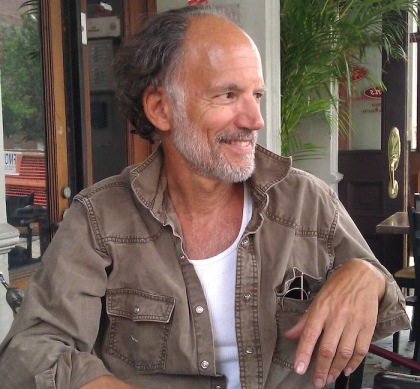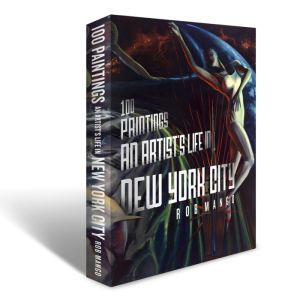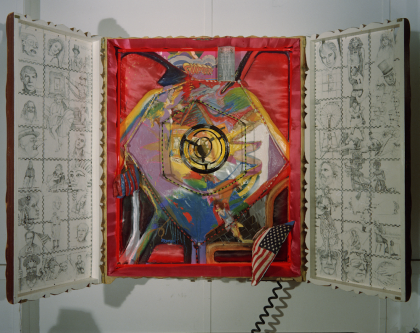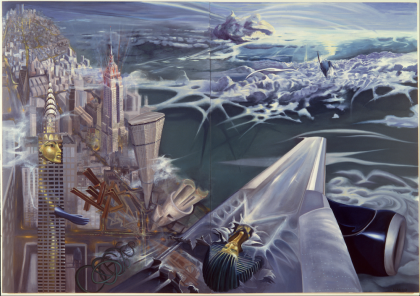Househunting with Bob Dylan in Tribeca

 When I learned that artist Rob Mango—whose gallery on Duane Park is a Tribeca institution—had a new book, 100 Paintings: An Artist’s Life in New York City, I assumed it was focused on his art. But it’s so much more: a memoir about his own life, and a vivid account of the birth of Tribeca as a residential neighborhood. He agreed to let me run several excerpts, along with the corresponding paintings. The book is available at Rob’s gallery at 178 Duane as well as robertmango.com, Amazon, and Barnes & Noble.
When I learned that artist Rob Mango—whose gallery on Duane Park is a Tribeca institution—had a new book, 100 Paintings: An Artist’s Life in New York City, I assumed it was focused on his art. But it’s so much more: a memoir about his own life, and a vivid account of the birth of Tribeca as a residential neighborhood. He agreed to let me run several excerpts, along with the corresponding paintings. The book is available at Rob’s gallery at 178 Duane as well as robertmango.com, Amazon, and Barnes & Noble.
Previously in this series:
••• Artist Rob Mango on Tribeca’s Pioneer Days
••• Rob Mango on Tribeca Becoming Tribeca
••• When Hollywood Royalty Came to Visit
••• Rob Mango on Opening a Tribeca Gallery in 1984
One of my most ambitious works to date was inspired during a return flight from Venice in 1989. I was visualizing Millennium from my seat in the airplane; looking out at a BOAC jet engine on the wing, I hallucinated New York City under it, even though we were over the Atlantic. When I built and stretched a canvas seven feet high and ten feet wide, I did not have a firm idea of what I was up to. I sat for six days, staring at the blank rectangle of canvas. I felt fearless and had little trepidation. I have used painting as a place to hide and as my only friend. More than this, I have used painting as the portal to seek the deeper truths; who am I and where did we come from and where are we going to? I needed to know, and this painting would tell me.
I scooped out a huge piece of space on the canvas. I gave the viewer the point of perspective from a passenger seat of a jet flying over New York. He looks out the window and sees the superrealistically rendered British Air jet engine, the city below, and skyline beyond. The picture has a multiple perspective line of sight. I painted the jet engine in such a way that you could put your arms around it. Three temporal views of New York are reflected in the architecture: past (downtown), present (midtown) and directly below, the future (uptown). The Chrysler Building’s sole occupant is “Sechret,” reaching out with her manganese hand for the pharaoh Tutankhamun, who passes by. He is arising, peeling himself out of the metal of the airplane wing, a metaphor for his journey through time. She is his guide through the underworld, accompanying him to reincarnation somewhere in the future. Toward the horizon, a mighty humpback whale arises from the clouds, fulfilling an ancient text: When the leviathan breaches the heavens, time begins again. Its ascent was foretold in antiquity to accompany the dawn of the millennium.
Millennium and other of my paintings from 1989 create an illusion of imagined space. The terms of entry are set forth in a glance; the viewer interprets them and drops into the space described. I strongly desired that kind of escape for the audience when they viewed Millennium—which is possibly why I invariably heard the “aha” sound when people saw it in the gallery. While standing in front of this picture, viewers seemed to lose their footing and fall in. It provided them an unexpected departure. It was still on my easel in my basement studio on the day I met Bob Dylan.
On a Friday morning in October, I was in Neo Persona, cleaning up after an opening party for the gallery artists and a solo show by Joe McNamara, a new exhibitor. Ann Marie was behind the counter when I saw a guy come to the door wearing an NYU sweatshirt with the hood drooped over his head. I turned to Ann and silently lip-synched his name to prepare her for a shock. Only a curly bonnet of hair and a legendary proboscis protruded out from the light grey hoodie. Bob Dylan carried a flat box under his arm, which turned out to be filled with his own watercolor sketches.
Bob did not respond well to Joe McNamara’s super-realist paintings on the walls, but he was chatting up the attractive Ann Marie across the gallery counter. He noticed a large triptych of mine on a side wall entitled Merger in the Wings—a satire of Wall Street that targeted the raucous corporate takeovers of investment brokerages of the 1980s. In the painting, merger mania is pictured as a shopping mall on 14th Street. This made him laugh, and when he laughed, so did the pair who followed him in, whom I surmised to be his secretary and his six-foot-five-inch bodyguard, disguised in an English three-piece suit. Bob and I sparred uncomfortably for several minutes as we walked the gallery, looking at McNamara pictures. The aesthetic philosophy of these realist paintings was antithetical to everything Dylan stood for as an artist. I told him, “I have been working on something very different—something dealing with subjects seldom seen in visual art. I summoned it from an unknown origin—could have been heaven, could have been hell.” That seemed to pique his interest. So the four of us walked over to my studio just across the Duane triangle.
My first impressions of Bob Dylan: He was cagey, distracted and confrontational, his eyes searching, his mind seemingly always working; he had an agenda or two on this day. We walked into my studio where he silently stalked the perimeter, looking at pictures on the walls. Bob approached The Superman Theory, eyeing the large cabinet of sculpted wood. I turned on the switch that illuminated the internal red neon and pulled the doors open. Dylan stepped back and took it all in. He seemed intrigued by its balancing act between pure theater; raw, expressive color painting; and fine detailed drawing. Its dual nature was both abstract symbolism and a narrative of the evolution of man from an animal of pure instinct through our intellectual and artistic giants—my chosen heroes of the century. If there was anyone on the planet who understood this tactic, it was the man standing before it. The Superman Theory balances inscrutability against a highly crafted object, lending it a classical feel that can’t be quickly categorized into any standard genre. For most, its narrative is not immediately obvious—but apparently that wasn’t the case with Bob. He stepped closer and examined the internal sides of the open doors. He saw all the supermen drawn in pen and ink detail and discovered himself, standing there playing the guitar, the stripes in his pants transmogrified from the veins in a large bronze skull held in the hands of Pablo Picasso. Those two men are my two primary artistic heroes; I consider them equals and arguably the greatest artists of the 20th century. The sketch of Bob Dylan appears in an ascending grid of the supermen, just above that of Picasso, with the Spaniard cradling the muse of man, represented by the bronze human skull sculpture in his hands.
 Above: The Superman Theory (1984–1988). Pen and ink on paper, neon, laminated wood, fabric, oil on sculpted panel; mixed media three-dimensional painting, sculpture. 61 x 52 x 10 in. Collection of the artist. Click to enlarge.
Above: The Superman Theory (1984–1988). Pen and ink on paper, neon, laminated wood, fabric, oil on sculpted panel; mixed media three-dimensional painting, sculpture. 61 x 52 x 10 in. Collection of the artist. Click to enlarge.
Apparently Bob was okay with the context I sketched him in. This may have been a turning point, and a rapport began to evolve between us. We walked downstairs into my painting studio, and when I flicked on the lights, his eyes immediately went to Millennium. To say Bob’s mind works at light speed is not even a slight exaggeration. He instantly connected the dots: civilization, nature, future, past, the universal spirit represented by the Egyptian, the eternal muse and, of course, New York. We began to speak about the painting in a kind of code we both understood, but it may have sounded like gibberish to the others. Bob walked around the picture, which sat on an easel eight feet high by twelve feet wide by six feet deep and on wheels. He looked at the back of the picture and shook it. He stepped back next to me and asked if he could take it onstage with him. Bob had just finished the ethereal, agonizing, confessional, gorgeous masterpiece Oh Mercy and was gearing up for a concert tour. He said a few words to his assistant, and she wrote down my phone number.
We headed upstairs and began to talk about a wide range of things—only one of which I will impart to you now, as it changed my artistic perceptions. In a box under his arm, Bob had his own paintings. He put the box down, unbuckled it, and showed me several remarkable watercolors. Every inch of these pictures exhibited purposeful draftsmanship, emotion and expression. Absolutely every line and brush stroke were charged with an intent that delivered a sensation. Bob seemed to have little use for a premeditated mark. My impression of his paintings: spontaneous, raw and as true as the human hand could impart. I told him so.
Bob asked me what I thought about the idea of putting out a book of reproductions of his watercolors and drawings. “You’re giving away your music and poetry,” I responded. Do you really want to do that with your paintings? They’re gonna want to publish them because you’re you. Is that going to be good enough? How might you feel about it later?” My intent was to suggest he may want to retain them for himself, as he had apparently done for years.
Bob took in my statement without expression. We rambled on for a while at a quickening pace, with his bodyguard looking on and the stenographer taking an occasional note. At that point, Bob told me something I cling to as pure artistic wisdom, and for which I am very grateful. He said, “When you’re painting a picture, don’t adjust it too much, or at all. Just make the thing and leave it alone.” He then added something I will never forget and which is now a fundamental belief guiding my work: “If you mess with it too much, it’ll suck the life out of it.”
Inevitably in 1989 in Tribeca, discussions turned to real estate. Speaking with Bob was no different; he too was intrigued with the neighborhood. Dylan asked me if I knew of any empty buildings we could take a look at. One such building that immediately came to mind was the Zenith Godley building at 176 Duane; it was strictly commercial and now abandoned. As its caretaker, I had a key.
Zenith Godley had housed a thriving butter, egg and dairy wholesale operation for 80 years. The building at 176 fronted on Duane, and the backside had large garage doors onto Reade Street where several semi-trailer cabs and trailers were often lined up. The upper floors of the five-story building were full of dozens of old cash registers, adding machines and telephones going back to the 1920s. Lower floors were littered with diesel engines retired from service resting on cinder blocks spilling oil, and still other floors had 30-foot-long original exterior signs, hand-lettered in rare typefaces reminiscent of a vintage American circus. Everything had the look and feel of a museum of old New York.
Bob had a nostalgic sensibility and loved old Americana. He was knocked out by the old cash registers and the look of the interiors, a place forgotten by time. But there was a problem: The neighboring building, a very low, two-story structure, allowed a view into the property that was lit from multiple surrounding windows. If you valued natural light, this was a plus, but it was a downside if privacy is para- mount. He asked me, “What would they take for the building?” I gave him a ballpark figure (under two million dollars). He dispatched me to initiate negotiations. We went over a few more of his priorities as to how he would like me to proceed. He wanted the building “as-is” with old gadgets and machines included. I suggested that we go around to the Reade Street side and look at the rear exterior and a few other properties.
The sun was shining brightly and it was a balmy fall afternoon—it had rained the night before. So I hit the sidewalk with Bob, and his little group followed behind. We stopped on the corner of Greenwich and Reade Streets and were talking about how the neighborhood had changed since he’d lived on Hubert Street in the mid-’60s. Suddenly, a full-size sanitation street-cleaning truck with two large spinning brushes came around the corner, taking advantage of the previous night’s puddles to scrub the curb. The security guy and stenographer were five feet back, but Bob and I got sprayed hard by the spinning brushes. I laughed immediately, then turned my head quickly to learn how he was handling it—we were really wet. Dylan grinned broadly and exposed a very substantial set of ivories and an expressive mouth; we trudged on as if nothing had happened.
We made our plans with regard to the building and my paintings, and he gave me the phone number of Naomi Saltzman, an associate of his former manager, Albert Grossman. Naomi and her husband Ben and I would become friends. Several days later, a limo with the Saltzmans pulled up to the studio and Helen and I got in. We cruised out to the New Jersey Performing Arts Center, an outdoor venue, to hear Bob perform selections from Oh Mercy. We went backstage to say hello. My association with Bob continued through his colleagues. (In the end, Bob decided not to purchase the building.)
Soon after I met Bob, I signed Millennium front and back. I had been communicating with Dylan’s front office about his using the painting onstage. There was a problem, however. The central image in the painting was an awakening Egyptian pharaoh; in addition, his bejeweled attendant Sechret was pictured too. Naomi informed me that there were those who counseled Bob on such things and they may have been worried that the Egyptians might be perceived as Arabs. Bob was a man of Jewish heritage who had shocked many Jews a decade earlier with his so-called “Jesus albums,” Saved and Long Train Coming (I loved these records). Now the brakes were being applied to his use of Millennium. He expressed his regrets to me through Naomi.
Bob and I met again briefly outside his forest-green trailer in which he crisscrossed the country; he preferred roads to airplanes at the time. It was in a parking lot behind a stadium after another New Jersey outdoor show. We had a few laughs and spoke briefly about art. He said he had decided against publishing a book of his paintings and drawings, and to keep them private for the time being. We talked about the direct approach to painting, upon which his expressive paint handling was founded. I repressed my disappointment about Millennium, but I hoped the time would come when Bob would have a Mango painting in his midst.
Below: Millennium (1989). Oil on canvas (two panels). 84 x 120 in. Collection of Andrew Gold. Click to enlarge.














I enjoy this immensely esp for two reasons: one, i got to meet and talk with Bob alone several years ago. Nice. No pressure. A real guy from the midwest, sort of, like me.
two: I somehow ended up at his front door of his house on ohayo mt road in woodstodk while he still onwed it. in one bay window were a couple of easels and some painting. I will bet that is the spot where he sat and paitned his self portrait for the record Self Portrait.
The sadness of his wealth and fame come through, but I think Bob wsa made to carry that load. He’s been fun. And your essay is as well. I love these kind of stories. Bob is great to meet!!!
The early lines of this would put the writer more in the Beatles’ camp than in Dylans’ since the BOAC brand which the writer claims to have observed in 1989 ceased to be used as early as 1974, on being subsumed, along with the BEA sister-brand, into the then new British Airways (BA).
“We cruised out to the New Jersey Performing Arts Center, an outdoor venue, to hear Bob perform selections from Oh Mercy. ”
The New Jersey Performing Arts Center is an INDOOR venue in Newark which didn’t open until 1997. The writer is probably referring to what was then known as the Garden State Arts Center in Holmdel, now known as the PNC Bank Arts Center.
I think the writer might be thinking of the Garden State Art Center (which is now the PIN center) and is an outdoor venue.
I though the same thing, majorlance. But something is not adding up. The period of this piece is October 1989. Bob’s Fall tour had him playing four shows at the Beacon Theater that October and none in New Jersey. http://www.bjorner.com/89-4.htm
Bob played the Garden State Arts Center in Holmdel, NJ, July 1989 (http://www.bjorner.com/89-3.htm), but the author hadn’t met Bob until October.
Interesting read anyway, true or not.
A very interesting, generous and welcoming, insightful and inspiring account of your experience with Bob Dylan, Rob Mango. Thank you for sharing. And so well expressed and written.
“Bob was a man of Jewish heritage who had shocked many Jews a decade earlier with his so-called “Jesus albums,” Saved and Long Train Coming (I loved these records).”
The correct album title is Slow Train Coming
good stuff here. First, we had the Basement Tapes….now we have The Building Tapes. Nice insight to the world of Bob when not on stage or in the studio.